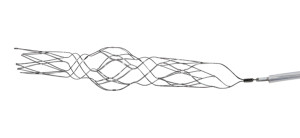
A single-centre study reports that stent-assisted coiling with the Barrel stent (Medtronic) is a feasible, safe, and efficient method for embolisation of intracranial wide-necked bifurcation aneurysms.
Writing in the Journal of NeuroInterventional Surgery, Ruben Mühl-Benninghaus and colleagues at the Saarland University Hospital, Homburg/Saar, Germany, describe their experience with 17 consecutive patients who underwent stent-assisted coil embolisation of wide-necked bifurcation aneurysms with the Barrel stent. They analysed the feasibility of successful deployment and post-treatment angiographic results. Adverse events, clinical outcome, and angiographic follow-up results were also reviewed.
The Barrel device is a self-expandable laser-cut stent developed with a bulged centre section. It is designed to treat wide-necked bifurcation or branch aneurysms without the use of a second stent and, as a consequence, to lower the metal-to-artery ratio and its inherent risk of thromboembolic complications of multiple stents.
“Deployment of the stent and herniation of its centre section was achieved in all cases. No kinking of the stent occurred. Treatment was successfully performed in 16 of 17 (94.1%) aneurysms. The cause of failure of the one case (5.9%) was the lack of access to the aneurysm with the microcather resulting in a residual aneurysm (RROC3). In this case, coiling was performed three months later resulting in total occlusion of the aneurysm. Complete occlusion (RROC1) was achieved in 11/17 cases (64.7%) and a residual neck (RROC2) remained in 5/17 cases (29.4%). No cases of stent migration or stent thrombosis occurred. No treatment-related mortality was observed. Treatment morbidity was encountered in one patient (5.8%) who developed a transient mild hemiparesis of the right arm after the procedure which resolved within 24 hours. Diffusion-weighted MRI showed no diffusion restriction after one hour and 24 hours after symptom onset,” the authors report.
In terms of follow-up, they add that 3–4 month short-term follow-up angiography is available in 13/17 patients (76.5%). One patient with incomplete occlusion (RROC2) showed complete occlusion at short-term follow-up resulting in a complete occlusion rate (RROC1) of 84.6% (11/13). A residual neck (RROC2) remained in 2/13 cases (15.3%).
As for the advantages of using the Barrel stent, Mühl-Benninghaus et al write, “The Barrel stent is used when sufficient coverage of a wide-necked bifurcation aneurysm could not be expected by classical stent-assisted coiling. Its advantages over X- and Y-stenting techniques are a lower metal-to-artery ratio and simpler handling requiring a single microcatheter and allowing repositioning due to its complete resheathability.” Further, they state that the stent’s unique bulged centre section “offers the possibility for better neck coverage than a conventional intracranial stent in the treatment” of wide-necked aneurysms, and it can therefore be an alternative to complex techniques like double stenting or balloon-assisted remodelling.
Finally, the authors maintain that further studies should be conducted to evaluate the mid-term and long-term efficacy and clinical utility of the Barrel device.
CE mark was granted to the Barrel device in December 2013.












